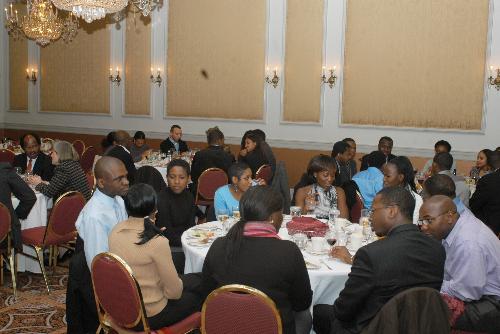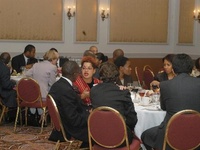
The Harvard African Students Alumni Network (HASAN) honored member Adebayo Ogunlesi, JD/MBA ‘79, at a reunion reception in 2004.
Worried that reunion events would cater to straight married couples and their children, some gay and lesbian alumni have stayed away from their class reunions in past years. Realizing this, the Harvard Gay and Lesbian Caucus (HGLC) began almost 10 years ago to organize events for gay and lesbian alumni during reunions, according to HGLC President Thomas H. Parry ’74.
Once reunions included these events, a greater number of gay and lesbian alumni felt more comfortable attending their reunions, Parry says.
Since 2000, alumni groups have expanded beyond the HGLC to include groups based on ethnic or religious affiliations, such as the Harvard Black Alumni Society (HBAS), the Harvard Arab Alumni Association (HAAA), and Harvard University Muslim Alumni (HUMA).
The Harvard Alumni Association (HAA), the umbrella alumni association for all graduates of Harvard University and Radcliffe College, created the Shared Interest Group (SIG) program in 2004 to incorporate other already-existing alumni organizations into the HAA.
For the HAA, SIGs provide an alternative to Harvard clubs and reunions as ways of bringing alumni into the HAA network.
“We want people to feel a part of the group and also of the HAA,” says HAA Assistant Director of SIGs Lauren Brodsky.
But SIG members say their groups’ links to current undergraduates are as important as the alumni connections, and as a result, they channel their efforts into improving the Harvard experience for current undergraduates who share their ethnic or religious affiliations or sexual orientation.
In turn, as the climate on campus has improved for members of these groups, their alumni feel more welcome in the alumni community, Parry says.
A ‘SEA CHANGE’
Parry, who also has served as an elected director of the HAA, says that the HAA went through a “sea change” in the last five years after it realized that alumni do not always relate to the university via geography-based Harvard Clubs or by their class year, historically the two major ways the HAA has reached out to alumni.
The HAA eventually realized that alumni were associating with one another on an ad hoc basis according to other similarities, Parry says.
The growing numbers of shared-interest groups are a manifestation of this change, and the creation of the SIG program makes it possible for the HAA to reach out to these groups.
“The HAA considers SIGs to be a critical part of what connects so many alumni with each other and with Harvard,” according to the HAA website.
The policy of the HAA to recognize and support SIGs was the product of a “very thoughtful, very detailed process,” according to Brodsky. In addition to the six current SIGs, Brodsky says the group Alumnae and Friends of Radcliffe College, created for alumni who share a bond with Radcliffe College, was recently granted SIG status.
In addition, Brodsky says she was in touch with five to nine groups in various stages of the process of becoming SIGs, and she expects more groups to apply.
“We definitely see this growing. It’s definitely a wonderful way to engage alumni,” she says.
In addition to groups such as the HGLC, the HBAS, and HUMA, SIGs include groups such as Harvardwood—a professional network for alumni involved in the arts—and the Harvard Glee Club Foundation.
COMMON CAUSES
Like more traditional organizations of alumni—such as regional Harvard clubs—the Harvard Arab Alumni Association focuses on providing networking opportunities and planning events for its members in the Arab world, according to director of external relations and former co-president Ashraf S. Hegazy ’96. These events include annual conferences in the U.S. and the Middle East.
Though the HAAA is not currently a SIG, Hegazy says it is likely that the HAAA will eventually apply to be recognized as one.
“I think it would be valuable for everyone if we were affiliated [with the HAA]. Our missions are the same,” he says.
The organization, founded in 2001, currently has about 200 members, drawn from all of Harvard’s schools. Hegazy says he anticipates a membership spike in the next few years, resulting in an HAAA membership of 2,000 to 3,000.
“Ethnicity is one thing that is with us our whole life, and especially for Arabs it affects us consciously everyday,” Hegazy says.
In addition to outreach within the alumni community, the HAAA has actively worked to increase the number of Arab students on Harvard’s campus. A group of current Harvard students visited the Middle East over intersession to recruit students to apply to Harvard, and HAAA connected them with alumni in the region.
PAYING IT FORWARD
Unlike the HAAA, the creators of HGLC identified helping undergraduates as its primary mission: the HGLC founders created the organization in 1984 to protest the University’s refusal to include sexual orientation in its non-discrimination policy. The lobbying efforts of the HGLC were successful, and in 1985, the University expanded the policy.
According to Parry, older gay, lesbian, bisexual, and transgender (GLBT) alumni tend to have had less-than-ideal Harvard experiences because they remained closeted while at Harvard. In response, Parry says, these alumni choose to join the Harvard Gay and Lesbian Caucus because of their “desire to make the [Harvard experience] better for Harvard students today.”
Though HAA policy prevents the HAA from taking a stance on current issues at Harvard, that policy does not prevent SIGs like the HGLC, which today has over 4,000 members, from continuing to lobby for changes on Harvard’s campus.
For instance, the HGLC was involved in the ten-year-long, and recently successful, push to change Harvard’s non-discrimination code to include gender identity and expression.
Parry also says the HGLC has a significant interest in helping to develop GLBT studies programs at the University’s various schools.
Members of the Harvard University Muslim Alumni also focus on undergraduate outreach, but with a different goal than HGLC’s activist work, says HUMA President Shahzad A. Bhatti, who graduated from HLS in 1997.
Bhatti says that a big priority of his organization, which was founded in 2004 and now has a membership numbering “in the hundreds,” is to create and support dialogue between Harvard Muslim students and the wider Harvard community. Bhatti also says the members of HUMA have expressed interest in creating a mentorship council that would connect alumni with current undergraduates.
One of HUMA’s “medium-term” goals is to have a mosque associated with the University built nearby.
‘A STARTING POINT’
Though the HGLC, the HAAA, and HUMA focus some or most of their efforts on working with undergraduates, HGLC’s Parry says the organizations are not designed to replicate their members’ undergraduate experiences. “You’ll never be able to re-create that,” he says.
Nor are specialized alumni groups solely for networking.
Instead, Parry says, SIGs, other specialized alumni groups, and the HAA provide graduates with “a starting point for people to make new friends.”
For GLBT alums, for instance, reunion events coordinated by HGLC have provided an opportunity to meet GLBT classmates they had never known at Harvard.
“Six or seven years ago, people were amazed that they could go to their reunion and hang out with their gay classmates,” Parry says. “Most of them never knew each other in school.”
—Staff writer Brittney L. Moraski can be reached at bmoraski@fas.harvard.edu.
Read more in News
University Jumpstarts Building Boom














